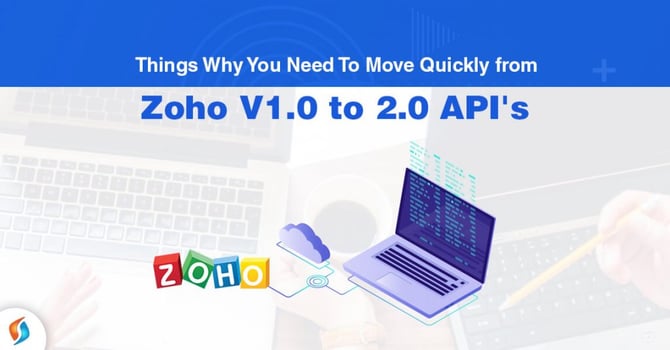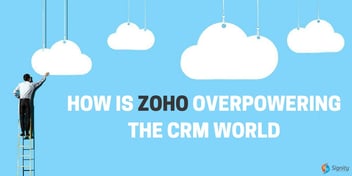Why Do You Need to Migrate From Zoho CRM API Version 1.0 to 2.0

An API is a set of a defined mechanism of communication between 2 or more systems. Hence, the API is supreme to the optimal functioning of integration with the CRM system. Zoho API is based on REST API that allows you to connect the CRM system with third-party applications. And in 2018, Zoho made an announcement that a new version of the API – Zoho V2.0 has been released and replaced the previous version V1.0.
Most people know that the support for the Zoho CRM V1.0 API has been depreciated on 31st Dec 2018 itself. Stating that Zoho will not provide any development support related to V1.0 API’s.
However, the functionality built-in that version of the API will remain active till Dec, 31st 2019 by sunset.
If you rely on Custom Functions, AI development services, or Deluge in any way, the update will promote a far-reaching effect on your current functionality.
Thus, it is very much important that you are familiar with what these features are and how you should prepare for the upcoming update.
Though the upgrade might sound a bit of a hassle, Zoho CRM V2.0 API is offering a lot of flexibility and additional features designed to improve the integration security with the third-party systems.
If you as a user is still using the V1.0 API’s, it’s time to upgrade the API as soon as possible to V2.0 in order to smoothen as well as fasten up the business processes.
Why switch to Zoho API v2.0?
With the current authentication method that V1.0 offers, a compromised API key could provide an unauthorized user with administrative privileges.
This security risk will no longer prevail with Zoho API V2.0 as there are no permanent access keys to be compromised. OAuth2.0 protocol offers users a secure and easy way to use authentication.
Additionally, Zoho API v2.0 offers several major enhancements over Zoho API v1.0:
- Significant Increase in the daily limits of API calls (up to 1,000,000 calls)
- Authentication via OAuth 2.0 protocol
- API V2.0 includes functionality related to Blueprints, approvals, and workflows
- Adherence to REST standards
- API 2.0 provides easy JSON parsing only however, API V1.0 was using JSON and XML parsing (XML was a bit old fashioned and slow as well)
- New API dashboard for better usage analytics
- Introduction of API names so that the changes in names (labels) of custom fields and custom modules won’t affect the existing integration and that was a long time need upgrade which developers and business owners were looking for.
- Date/Time field values will be updated to the ISO 8601 format that includes the time zone.
- Better Support for Mobile SDKs, JavaScript SDKs, and Server-side SDKs.
- Introduction to share some of the permissions on the module as well as records accessibility
This is not the end of the feature list of the new Zoho CRM API 2.0. There is a ton of the plate that Zoho development services are offering and constantly improving to make the customer experience better.
API Methods of Zoho CRM Oauth 2.0
[table width="850" colwidth="200|400" colalign="center|center"]
Command, Use
getRecords, To retrieve all user data specified in the API request
getRecordById, To retrieve individual records by record ID
getDeletedRecordIds,To retrieve the list of IDs of deleted records from recycle bin
insertRecords, To insert records into the required Zoho CRM module
updateRecords, To update or modify the records in Zoho CRM
getSearchRecordsByPDC, To search the values based on predefined columns
deleteRecords, To delete the selected records
convertLead, To convert leads to potential | account and contact
getRelatedRecords, To retrieve records related to a primary module
getFields, To retrieve the details of fields available in a module
updateRelatedRecords, To update records related to another record
uploadFile, To attach a file to a record
delink, To disassociate the relationship between parent and child records
downloadFile, To download a file attached to a record
deleteFile, To delete a file attached to a record
uploadPhoto, To add a photo to a contact or lead
downloadPhoto, To download the photo of a contact or lead
deletePhoto, To delete a photo of a contact or lead
getModules, To retrieve all modules from the Zoho CRM account
searchRecords, To retrieve the records that match your search
[/table]
Source: Zoho
Summarizing V2 Vs V1
Field Attribute changes:
[table width="850" colwidth="200|400" colalign="center|center"]
API Version 1.0, API Version 2.0
{MODULE}ID (Ex. LEADID), id
SMOWNERID, id given within the Owner JSONObject.
{MODULE} OWNER (Ex. Lead Owner), name given within Owner JSONObject.
SMCREATORI, name given within Created_ByJSONObject.
MODIFIEDBY, id given within Modified_By JSONObject
Modified By, name given within Modified_ByJSONObject
[/table]
Source: Zoho
Field Format types:
[table width="850" colwidth="200|400|400" colalign="center|center|
Field Type, V 1.0 Format, V 1.0 Format
Single Line, <FL val=”Single_Line 1″> <![CDATA[this is single line]]> </FL>, “Single_Line_1”: “This is single line”
Multi Line, <FL val=”Multi-Line 1″><![CDATA[this is a multi line second line]]></FL>, “Multi_Line_1”: “This is \multi line\second line”
Email, <FL val=”Email”><![CDATA[email@zoho.com]]><FL>, “Email_1”: “email1@email.com”
Phone, <FL val=”Phone 1″><![CDATA[9900000000]]></FL>, “Phone_1”: “9900000000”
Picklist, <FL val=”picklist1″><![CDATA[one]]></FL>, “picklist1”: “one”
Multi-select Picklist, <FL val=”Multi-Select 1″><![CDATA[Option1;Option 2]]></FL>, “Multi_Select_1”: [ “Option 1”| “Option 2”]
Date, <FL val=”Date 1″><![CDATA[2018-03-29]]></FL>, “Date_1”: “2018-03-29”
Date/Time, <FL val=”Date/Time 1″><![CDATA[2018-04-07 10:00:00]]></FL>, “Date_Time_1”: “2018-04-07T10:00:00+05:30”
Number, <FL val=”Number 1″><![CDATA[50000]]></FL>, “Date_Time_1”: “2018-04-07T10:00:00+05:30”
Currency, <FL val=”Currency 1″><![CDATA[230000500]]></FL>, “Currency_1”: 230000500
Decimal, <FL val=”Decimal 1″><![CDATA[1234.9]]></FL>, “Decimal_1”: 1234.9
[/table]
Upgrade from API V1.0 to API V 2.0 in just a few steps:-Source: Zoho
- Hire an outsourcing team of developers, who will help you develop a comprehensive action plan with a proper impact assessment of CRM functionality
- Initially, Zoho Developers will review and analyze the existing scripts, workflows and API’s integration functionality that use Zoho API. This, in turn, will make the upgrading process hassle-free as well as smooth delivery can be made accordingly.
- If there is any requirement of adding Blueprint and layout functionality, then we can do it via API 2.0
- Test the entire system and validate your new code to ensure there are no interruptions when migrating to API V2.0. I am sure your user experience will be much more efficient with new Zoho CRM functionalities.
Related Read: Let Our Zoho Developers Help You Build Your Business [Proven Results]
Moreover, for more information, please refer to the deprecation of API v1.0 announcement and the migration document from API v1.0 to API v2.0.
However, If you are not familiar with the upgrading process, contact Signity Solutions for a Free Consultation.
We are licensed Zoho CRM consultants and will help you unlock practical use cases related to the new Zoho API version according to your industry vertical. I am sure, together we can make a great tech and solution team.



.png?width=344&height=101&name=Mask%20group%20(5).png)
















